Key takeaways:
- Traditional publishing offers prestige, a support system, and financial advances but may limit creative control and involve lengthy processes.
- Self-publishing provides creative autonomy, faster market entry, and higher royalties but requires authors to manage marketing and assumes greater financial risk.
- Choosing between traditional and self-publishing depends on aligning personal goals and audience engagement preferences.
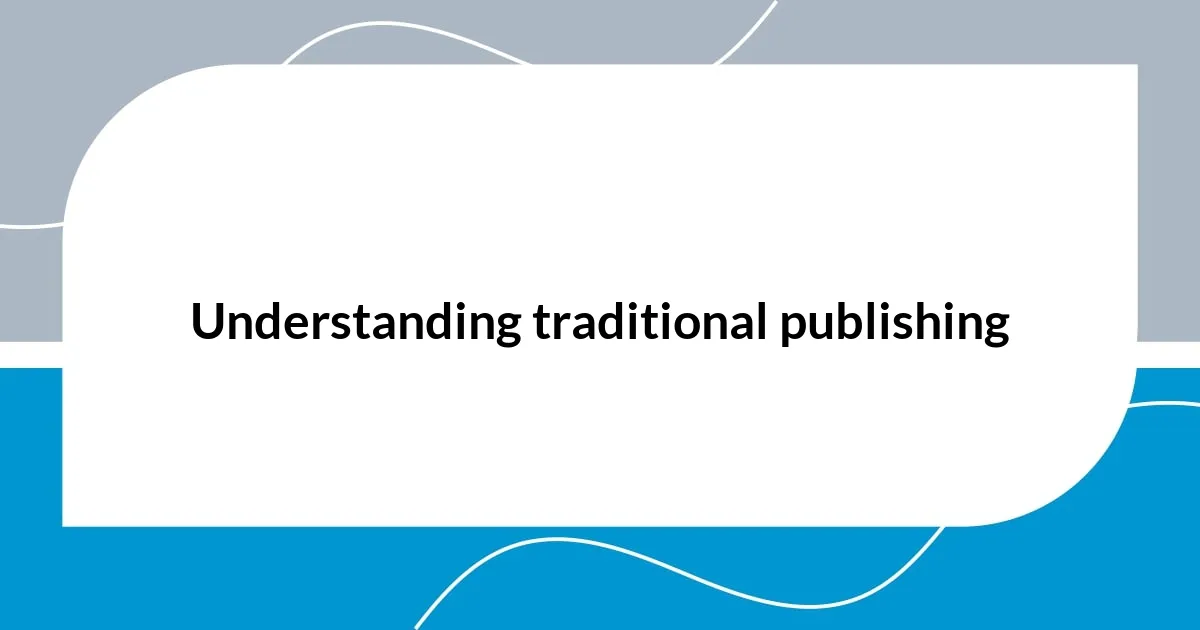
Understanding traditional publishing
Traditional publishing is a well-established route for authors looking to reach a larger audience through reputable channels. I still remember the first time I held a book from a traditional publisher; the feel of the cover and the aroma of fresh ink felt almost magical. It’s a process that often involves submitting manuscripts, going through multiple rounds of reviews, and eventually, entering a collaborative relationship with editors and publicists. Have you ever thought about how fulfilling it must feel to see your name on a professionally printed book?
The traditional publishing landscape can be daunting, with publishers typically taking on a limited number of titles each year. I personally find this selective process to be both a double-edged sword and a necessary filter. While it’s tough for new authors, this filtering often means that the books that do make it are polished and market-ready. But isn’t there something incredibly validating about knowing that industry professionals chose your work for publication?
Furthermore, traditional publishing usually offers financial advances and support in distribution and marketing. I remember chatting with a friend who secured a deal with a traditional house, and his excitement was infectious. That’s the kind of backing that can propel a book into the hands of eager readers. However, it also comes with expectations, deadlines, and sometimes a loss of creative control—have you pondered what you would be willing to compromise?
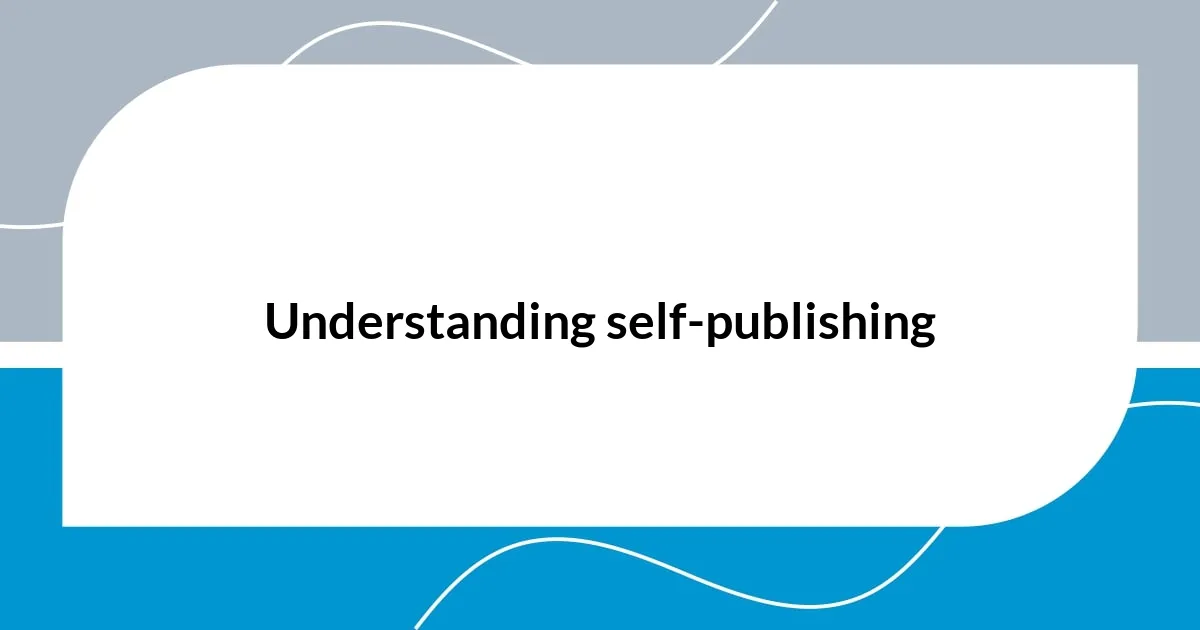
Understanding self-publishing
Self-publishing provides authors with an exciting alternative to traditional routes. I remember the thrill I felt when I decided to publish my own book; it was empowering to take charge of my work entirely. More than just a way to get my writing out there, self-publishing allowed me to connect directly with my audience, a factor that I found both liberating and daunting.
Here are some key aspects of self-publishing:
- Creative control: As a self-published author, you steer the entire process, from cover design to marketing strategies.
- Speed to market: I was amazed at how quickly I could publish; no long waits for approval or editing timelines.
- Higher royalties: Unlike traditional publishing, where the publisher takes a significant cut, self-publishing enables you to earn a larger percentage of your book’s sales.
- Building a direct relationship with readers: I cherish the moments when readers reach out to share their thoughts; it feels like a personal connection.
- Flexibility: You can adjust your approach based on what resonates with your audience without the constraints of a publisher’s limitations.
In my experience, self-publishing isn’t just about putting words on a page; it’s about building a brand and a community around your work.
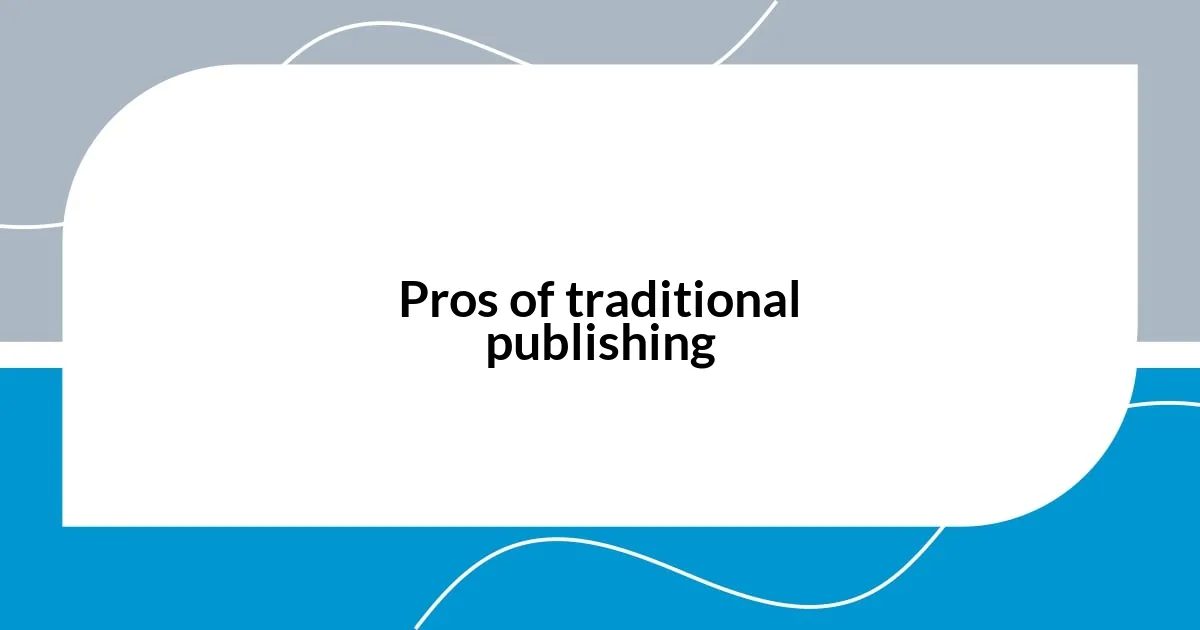
Pros of traditional publishing
The prestige associated with traditional publishing can’t be overstated. I remember visiting a bookstore where the shelves gleamed with hardcovers from major publishing houses. Each spine told a story, not just of its content, but of a rigorous selection process by industry experts. That sense of legitimacy is something many authors yearn for, as it often translates into wider recognition and respect within literary circles.
One of the standout benefits is the access to a robust support system. When my friend signed with a traditional publisher, he didn’t just gain a contract; he received a whole team dedicated to his book’s success. Editors, marketers, and even graphic designers collaborated to create a polished final product. This kind of extensive backing can be incredibly reassuring for authors who might feel overwhelmed by the daunting task of going it alone.
Another key advantage lies in financial stability. Traditional publishers often provide advances, allowing authors to focus on their writing without the immediate worry of income. I once spoke to an author who used her advance to dedicate herself fully to her craft for several months. It was inspiring to hear how such financial support can create space for creativity to flourish, transforming dreams of authorship into a tangible reality.
| Pros of Traditional Publishing | Description |
|---|---|
| Prestige and Legitimacy | Being associated with established publishers brings recognition and respect within the literary community. |
| Comprehensive Support System | Access to a dedicated team of editors, marketers, and designers enhances the quality and reach of the book. |
| Financial Advances | Publishers often provide advances that allow authors to focus on writing without immediate financial pressures. |
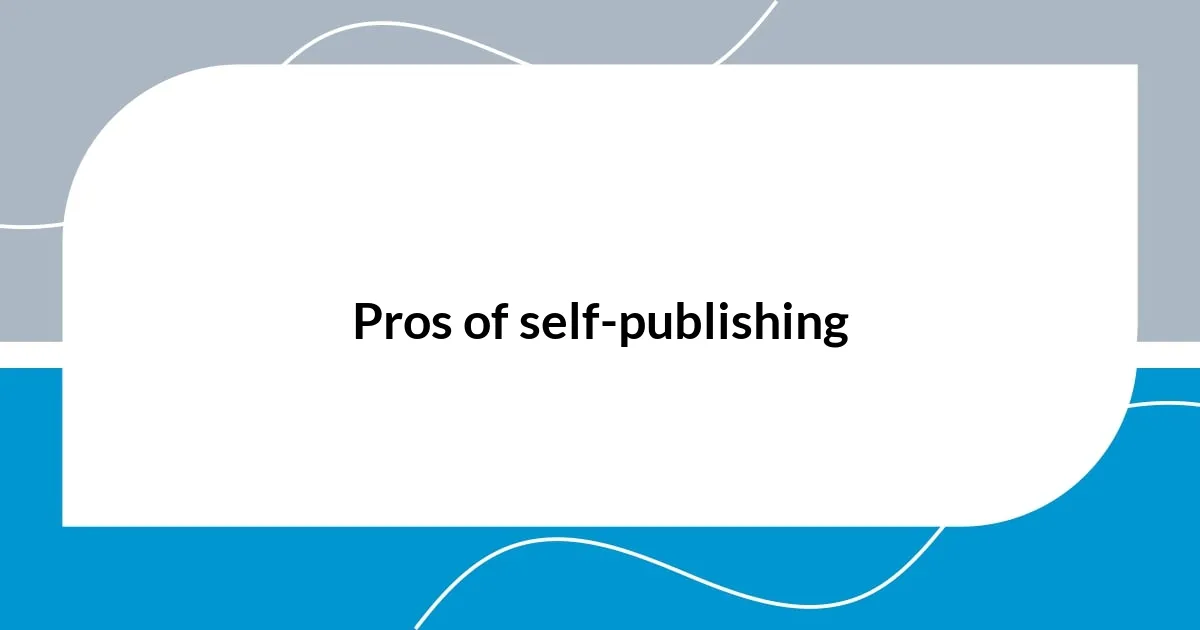
Pros of self-publishing
Self-publishing opens up a world of creative control that many authors dream about. I vividly remember choosing every element of my book’s cover and layout, a process that felt so personal. How many times have you wished to have the final say in your project? In self-publishing, that wish becomes your reality, allowing you to express your vision exactly as you imagine it.
The speed to market is another vital advantage. When I self-published, I hit “publish” and watched my book go live within days—there’s nothing quite like that rush! This quick turnaround not only kept my excitement alive but also ensured that my content was relevant to the moment, letting me respond swiftly to trends and reader feedback. Isn’t it invigorating to think that your words could be shared with the world almost instantly?
One aspect I cherish is the relationship I’ve built with my readers. When they reach out to me after reading my book, it’s deeply fulfilling. This direct interaction provides invaluable insights into what resonates with them, shaping my future writing. In what other arena can we so closely connect with those who appreciate our work? The community I’ve fostered is something I wouldn’t trade for any traditional publisher’s backing.
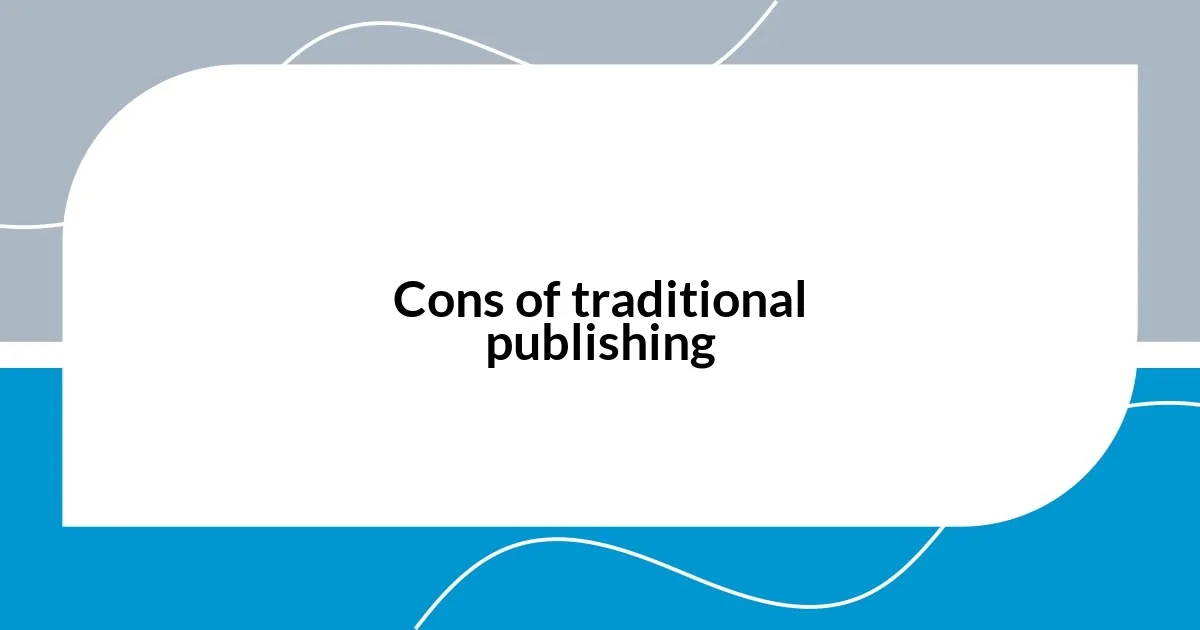
Cons of traditional publishing
There are several downsides to traditional publishing that can be disheartening for aspiring authors. One significant issue I noticed is the lengthy process it often requires. Several years ago, a friend of mine spent almost a year just waiting for a response from a publisher! The uncertainty in that waiting game can really drain an author’s enthusiasm—who wouldn’t feel anxious about their work being in limbo for so long?
Additionally, I’ve seen how creative control can slip through an author’s fingers. When my mentor published through a major house, she found herself frustrated by changes made to her story and cover. It’s hard to pour your heart into a manuscript only to see it molded by others who may not fully understand your vision. Isn’t it agonizing to think about others owning the final say over something that’s so personal?
Moreover, the financial cut taken by traditional publishers often raises eyebrows. I was shocked when I learned that my cousin, who had an impressive deal, ended up with only a fraction of the earnings from her book sales. After investing so much time and energy, it felt unfair for her to receive such a small payout. Aren’t authors deserving of more for all the hard work they put in?
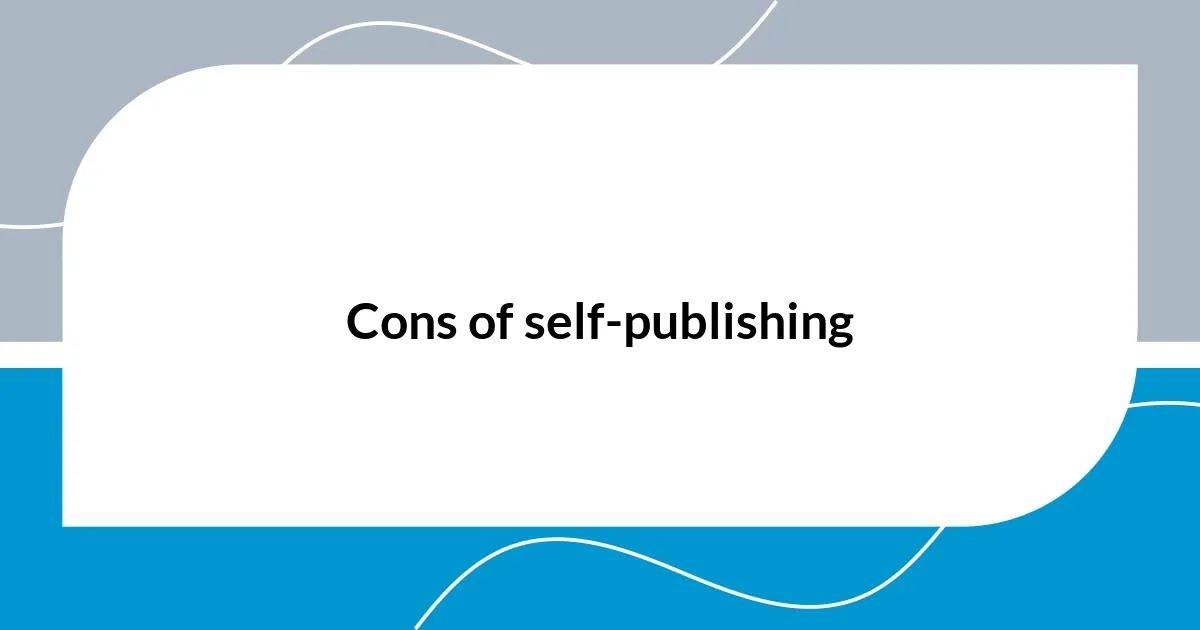
Cons of self-publishing
Self-publishing comes with its own set of challenges that are hard to ignore. One of the most daunting parts, from my experience, is the complete responsibility for marketing. I remember launching my first self-published book and feeling overwhelmed by the sheer amount of promotion I had to manage. Who knew that creating social media posts, reaching out to bloggers, and organizing virtual book tours would consume so much of my time? It can be exhausting, and without a marketing background, it might feel like an uphill battle.
Another hurdle I faced was the lack of professional support. Unlike traditional publishing, I didn’t have a team of editors, designers, or publicists holding my hand. I had to wear many hats, and while it’s gratifying to take on these roles, it can also lead to mistakes. I once missed a typo in my manuscript that ended up in print, and it stung. Have you ever felt that sinking feeling when realizing a small error made it out into the world? It’s a tough pill to swallow when you’re your own publisher.
Financial risk is another major concern. Investing in self-publishing can feel like walking a tightrope without a safety net. I’ve poured my savings into professional editing and cover design, hoping for a lucrative return. But more often than not, the financial rewards are not what we hope for. Isn’t it frustrating to put in all that effort and not see the results you envisioned? I think many self-published authors grapple with the challenge of turning their passion into profit.
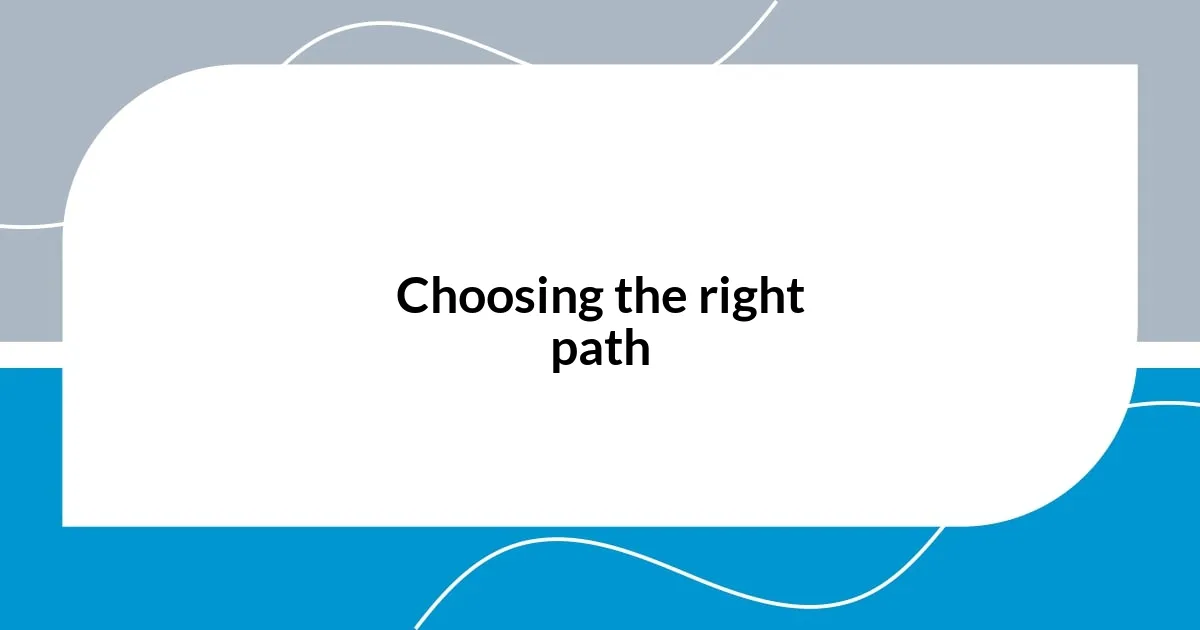
Choosing the right path
Choosing the right path in publishing is undoubtedly a significant decision for an author. I remember standing at that crossroads myself, feeling both excitement and fear. It’s like choosing between a safe, established road or a winding path filled with surprises. I often wonder, how do you weigh the pros and cons?
One thing I’ve learned is that aligning your personal goals with your publishing choice is crucial. For some, maintaining creative control is essential. I once knew an author who longed for the freedom to design her own cover and dictate her narrative style. When she chose self-publishing, it was liberating, but I could see the accompanying weight of responsibility—it created a dichotomy. Have you thought about what truly matters to you as a writer?
Moreover, I’ve found that considering your audience can guide your decision. If you crave the sense of community and validation that comes from a traditional publisher, go for it! Conversely, if you’re eager to connect with readers directly and cultivate a personal brand, self-publishing might be your best bet. I often ask myself, who do I want to reach, and how do I want to engage with them? Understanding that dynamic can be a game changer in choosing your path.